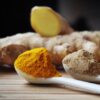The current climate is causing a lot of fear in people. Our lives have been disrupted and fear about some pretty serious stuff like loss of income, lifestyle, freedom, and health infection have all been thrown into the melting point of our emotions. There is only so much that our attempts at shielding children from those swirling emotions can do. Even the most secure child is likely to feel fear and anxiety from just all the mask wearing going on, let on the frequent school closures, physical distancing, new routines and constantly changing routines.
But one key area that you do still have some level of influence over, that you may not have thought of, is food. What happens in the gut can, because of the gut-brain connection, alter your mind, mood and behaviour.
The connection is well recognized but tends to get forgotten all the time.
Some simple examples: when you are nervous you feel it in your stomach and bowels. When you eat something you are sensitive to, you feel mentally sluggish. So when the emotions play up in our kids, it seems you can soothe with food.
Let’s unpack how to use food to soothe the anxious brain. There are 3 key things you can do. The first 2 can be brought in straightaway but the last one does need a bit more thought and help.
One. Keep those blood sugar levels steady. The brain is a very sugar hungry organ. Around 20% of the glucose you have circulating around in your body wants to be used by the brain to keep it firing and being the master organiser it needs to be. When that glucose fluctuates, it’s not happy. In fact, it gets hangry. That can leave anyone feeling a little on edge, more fearful, and more worried. Moods will swing, drop rapidly, and anxiety will fly up. To flatten the curve (yes, that’s a play on words) you need to increase 2 key food groups: proteins, and fats.
Protein Protein is a star player in the brain. It breaks down into amino acids which are needed to make the neurotransmitters for mood health and concentration. The best times for a child with anxiety to have protein is breakfast, morning tea, and straight after school (if that’s happening).
Fats Don’t be afraid of fats and be more heavy handed with them than you might think is ok. Forget the low fat stuff for kids but it does need to be GREAT fats. EVOO is the star; oily fish; chia seeds; nuts and seeds and nut butters; avocado; ghee and butter; yoghurt are all examples of good fats. (If you’re concerned about their weight, you still need to keep in plenty of the good fats, although there are some other tweaks you need to make as well, but that’s another story).
Why am I saying this? The brain needs plenty of fats to build and strengthen connections between the cells, and to keep that internal communication firing along as it should.
Two. Change the timing of when certain foods are eaten. Emphasising protein in the main part of the day, then backing off and bringing in more carbs helps the kids who hold it all in during the day at school but then let it all out at home. It can be a simple but effective way to lighten those afternoon meltdowns.
How this could play out:
BREAKFAST. Eggs or baked beans on toast, leftover sausage on sandwich, protein shake/ smoothie, nut and seed bread, hemp seeds and LSA on porridge.
MORNING TEA. Biscuit or muffin with nuts/ seeds/ protein powder in the mix, nut or seed bar, paleo style bars or nut bars if possible, protein shake. You’re trying to get a nice mix of protein and fats in the earlier part of the day.
LUNCH. Now kids are ready for more starchy foods, so a sandwich is ideal, pasta salad, rice salad, or potato salad. Still want some protein in there, but quantities are not as critical if the morning tea provided it.
AFTERNOON TEA Best option is a mini meal. Some families aim to have dinner at this time because it stops those late afternoon meltdowns very well! If this is when the starchy carbs are eaten the most, the scene is being set for trouble. Think chips, crackers, toast, sugary cereal, cake, iceblocks etc. If there hasn’t been the protein and fats earlier on in the day they will lose the plot because they haven’t got long term energy reserves on hand. So ravenous carb consuming can happen in an attempt to prop up energy and moods for the rest of the day.
But here’s the problem, it’s a temporary solution. Too many starchy carbs will spike the blood sugar, then drop it and that’s when you see irritability and tension come in because the brain is feeling tired. It’s easy to overeat carbs too but that just keeps the problem hanging around for longer.
DINNER if they get a mini meal at afternoon tea, and they are not hungry at dinner, you can keep it really light eg a sandwich. Or a starchy meal like pasta, potato bake, even cereal or porridge because now it’s ok to have a tired brain, ready for sleep.
Three. Find and remove trigger foods. In a healthy body, most food is completely digested before it passes through the gut lining and into the bloodstream. But maybe your child can’t make enough enzymes needed to break down the food well enough and that means partially digested foods.
This can cause digestive problems in the short term with bloating, gas/ wind, burping, constipation and/or diarrhoea making appearances on a regular basis. In the long term it means problems with weight balance, fatigue, brain fog, anxiety/ depression, immune issues, skin issues or attention and behavioural problems.
If you have your hunch about a food, you can experiment and take it out for a few weeks and see what you think. But if you want to play with more than one food or group, its best to get help. Children can become nutritionally deplete too easily when their diet is limited. Hint: that’s when you call me for an appointment.
NUTRIENTS FOR MENTAL HEALTH
1. Protein 3 times a day – animal sources once or twice, vegetarian for the others eg eggs, legumes, protein powder in a milkshake, yoghurt, muffin mix, pikelet. Amino acids, B vitamins, iron. Why? For energy, both mentally and physically. Reduces sugar cravings and that preference for starchy foods.
2. Nuts & seeds: almonds, walnuts, cashews, brazil nuts, pumpkin seeds (pepitas), sunflower seeds, sesame seeds eg. blend into a drink or pikelet mix, sprinkle over desserts or porridge. LSA is finely ground up linseeds, sunflower seeds and almonds which is readily available. You can get vitamin B6 from food sources like fish, lean meats, egg whites and cabbage. Magnesium, B6, Zinc
Why? Magnesium is effective for its calming effects and when combined with vitamin B6, provides a highly effect but safe and natural approach to reducing anxiety. Zinc is important for healthy mood balance and reduces mood swings and anxiety.
3. Seaweeds, lean meats, nuts, onions, garlic, legumes and cabbage Why? For the amino acid taurine which works alongside other amino acids to encourage a sense of calm.
4. Oily fish, fish oil supplements Why? To provide EPA & DHA which plays multiple roles in brain health, by building up cell membranes of all brain cells and assisting those cells to function normally. It also plays a primary role quenching inflammation in the brain. Anti-inflammatory nutrients are essential for brain tolerance of stress and brain recovery from stress. Interesting point: anxiety is beginning to be seen as a condition resulting from excessive inflammation in the nerves. TOP SUPPLEMENT PICKS FOR KIDS Ethical Nutrients Mega Magnesium Night. A fruit flavoured blend of magnesium, glycine and the herb passionflower to soothe irritated nerves, and regulate blood sugar. Don’t have to use it only at night! (From health food stores and chemists) Allergy friendly alternatives. These options all emphasise B vitamins for mood and sleep regulation, and are only available for practitioner prescription. Ask me about these ones.
- MTHFR Support Starter B vitamins. Powder, unflavoured. MTHFR SUPPORT STARTER B POWDER B vitamins (allergy friendly)
- MTHFR Support Total Methyl B vitamins. Powder, unflavoured.
- Orthoplex Methyl1c Bioenhanced. Capsule.





